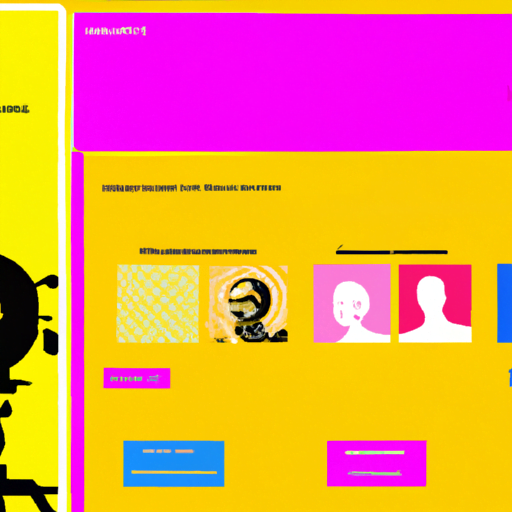
-
Table of Contents
- Interface Design for Job Portals and Freelancing Platforms
- The Importance of Interface Design
- Key Principles of Interface Design
- Best Practices for Interface Design
- 1. Clear and Intuitive Navigation
- 2. Personalized Recommendations
- 3. Streamlined Job Application Process
- 4. Showcase Freelancer Profiles
- Case Studies and Statistics
- Case Study: Upwork
Interface Design for Job Portals and Freelancing Platforms

Job portals and freelancing platforms have become essential tools for both job seekers and employers in today’s digital age. These platforms provide a convenient and efficient way to connect talent with opportunities. However, the success of these platforms heavily relies on their interface design. A well-designed interface can enhance user experience, increase engagement, and ultimately drive the success of the platform. In this article, we will explore the key principles and best practices for interface design in job portals and freelancing platforms.
The Importance of Interface Design
Interface design plays a crucial role in the success of job portals and freelancing platforms. It is the first point of contact between users and the platform, and it significantly impacts user engagement and satisfaction. A poorly designed interface can lead to frustration, confusion, and ultimately, users abandoning the platform in search of alternatives.
On the other hand, a well-designed interface can provide a seamless and intuitive user experience, making it easier for users to navigate the platform, find relevant opportunities, and connect with potential employers or freelancers. A visually appealing and user-friendly interface can also help build trust and credibility, encouraging users to spend more time on the platform and engage with its features.
Key Principles of Interface Design
When designing the interface for job portals and freelancing platforms, several key principles should be considered:
- Simplicity: Keep the interface simple and clutter-free. Avoid overwhelming users with too much information or too many options on a single screen. Use clear and concise language to guide users through the platform.
- Consistency: Maintain consistency in design elements, such as colors, typography, and icons, throughout the platform. Consistency helps users develop a mental model of the platform and makes it easier for them to navigate and understand its features.
- Accessibility: Ensure that the interface is accessible to users with disabilities. Follow accessibility guidelines and provide alternative text for images, clear and readable text, and keyboard navigation options.
- Visual Hierarchy: Use visual cues, such as size, color, and placement, to create a clear visual hierarchy. Highlight important elements, such as job listings or freelancer profiles, to draw users’ attention and guide them towards their goals.
- Feedback and Validation: Provide immediate feedback to users when they perform actions, such as submitting an application or posting a job. Use validation techniques, such as error messages or confirmation dialogs, to ensure that users understand the outcome of their actions.
- Mobile Responsiveness: With the increasing use of mobile devices, it is crucial to design interfaces that are responsive and optimized for different screen sizes. A mobile-friendly interface allows users to access the platform on the go and enhances their overall experience.
Best Practices for Interface Design
Now that we have explored the key principles of interface design, let’s dive into some best practices specifically tailored for job portals and freelancing platforms:
1. Clear and Intuitive Navigation
Navigation is a critical aspect of any platform, and job portals and freelancing platforms are no exception. Users should be able to easily navigate through different sections of the platform, such as job listings, freelancer profiles, and account settings. Here are some best practices for navigation:
- Use a clear and visible navigation bar or menu that remains consistent across all pages.
- Organize navigation items logically and categorize them to make it easier for users to find what they are looking for.
- Include a search bar prominently to allow users to search for specific jobs or freelancers.
- Provide breadcrumbs or a clear path indicator to help users understand their current location within the platform.
2. Personalized Recommendations
Personalization is a powerful tool to enhance user engagement and satisfaction. By leveraging user data and preferences, job portals and freelancing platforms can provide personalized recommendations for jobs or freelancers that match the user’s interests and skills. Here are some ways to incorporate personalization:
- Collect user data during the registration process or through user profiles to understand their preferences, skills, and experience.
- Use machine learning algorithms to analyze user data and provide personalized job recommendations based on their interests and past interactions.
- Allow users to customize their preferences and receive notifications or emails for new job opportunities or relevant freelancers.
3. Streamlined Job Application Process
The job application process can be time-consuming and complex, especially for job portals with a large number of applicants. A streamlined and user-friendly application process can significantly improve user experience and increase the chances of successful applications. Consider the following best practices:
- Break down the application process into clear and manageable steps, guiding users through each stage.
- Pre-fill application forms with relevant information from the user’s profile to save time and reduce repetitive data entry.
- Provide clear instructions and guidelines for each section of the application, ensuring that users understand what is expected.
- Allow users to save their progress and resume the application at a later time.
4. Showcase Freelancer Profiles
For freelancing platforms, the freelancer profiles play a crucial role in attracting potential clients. A well-designed freelancer profile can showcase the freelancer’s skills, experience, and portfolio, helping them stand out from the competition. Consider the following best practices for freelancer profiles:
- Provide a visually appealing and customizable profile layout that allows freelancers to highlight their expertise and showcase their work.
- Include a rating and review system to build trust and credibility among clients.
- Allow freelancers to upload their portfolio, including samples of their work, certifications, or testimonials.
- Include a section for freelancers to describe their skills, experience, and preferred types of projects.
Case Studies and Statistics
Let’s take a look at some case studies and statistics that highlight the impact of interface design on job portals and freelancing platforms:
Case Study: Upwork
Upwork is one of the leading freelancing platforms globally, connecting millions of freelancers with clients. In 2014, Upwork underwent a major redesign of its interface to improve user experience and increase engagement. The redesign focused on simplifying the navigation, enhancing the search functionality, and providing personalized recommendations. As a result, Upwork reported a 400% increase in job applications and a 175% increase in freelancer sign-ups within the first year of the redesign.
